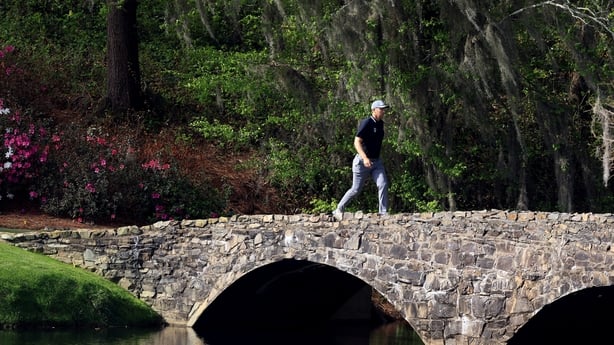Irish interest at this year's Masters is particularly strong with four players in the field, but the famous Augusta course also has a major contribution from these shores in the form of the famous Rae’s Creek.
Those two words will be on the mind of Rory McIlroy, Shane Lowry, Seamus Power and Padraig Harrington as they plan their approach to today’s opening round in Georgia - and the famed hazard owes much to McIlroy’s fellow County Down man John Rae.
Rae's Creek is a main feature of Amen Corner and runs in front of the 12th green, has a tributary evident at the 13th and flows at the back of the 11th. The noted Hogan Bridge, which takes players onto the 12th green, crosses the creek and is one of the most photographed spots in all of golf. Nelson Bridge also travels across the body of water.
The creek was named after property owner John Rae, who emigrated from Ballynahinch in either 1729 or 1730 and was granted large swathes of land where he built Rae’s Hall. The Irishman lived just southeast of the creek's confluence with the Savannah River.
Rae, who referred to it as stony creek, was a powerful man on the Georgia land scene and owned some 8,000 acres at a time. It was that influence that saw the slave owner pardoned in 1771 of the manslaughter of Savannah native Ann Simpson.
"All his friends petitioned on his behalf, stating that he had been in the province for nearly 40 years and had an unblemished character and had filled many offices of public trust. He had also been a member of the Georgia Assembly, which was a very highly respected position in the province," the book Colonial Georgians tells us.
On 18 December, 1771, two petitions were read out at the council in Savannah – one by members of the province and the other by James Habersham, president of the council. The latter stated that the death was "an act of indiscretion, than bad intention," according to the minutes, with the board unanimously deciding that Rae was "a fitting object of mercy and advised his honour to grant him a pardon".

Publicly, at least, there hasn’t been any campaign to rename the creek, but things tend to move at a glacial place at the most famous golf club in the world.
It didn’t admit its first black member, television executive Ron Townsend, until 1990 and didn’t offer membership to women until 2012 when Condoleezza Rice and Darla Moore were invited to join.
So for now, despite its chequered origins, Rae’s Creek will play an integral part in the 86th Masters and no doubt cause the capitulation of some of the 91 contenders.
It will provide the backdrop to the 12th hole, Golden Bell, perhaps the most famed hole in world golf alongside the Road Hole at St Andrews.
It torpedoed Greg Norman’s charge in 1996 and, in more recent times, was responsible for Jordan Spieth’s meltdown in 2016 as he coughed up four shots when one arm seemed to already be in the green jacket. Five years later, after missing a short putt, the American tapped in, lifted his ball and hurled into the creek. Its scars still hurting.

For McIlroy, Lowry, Power and Harrington, they’ll be hoping that they need to hold their nerve four times on the famous 12th. In the days to come, the creek will be viewed through the lens of a destabiliser to the world’s best golfers.
In time though, that part of Rae’s Creek that cuts through Amen Corner, bought by a consortium headed by golf legend Bobby Jones in the 1930s, may have to revaluate if the name is still fitting.

